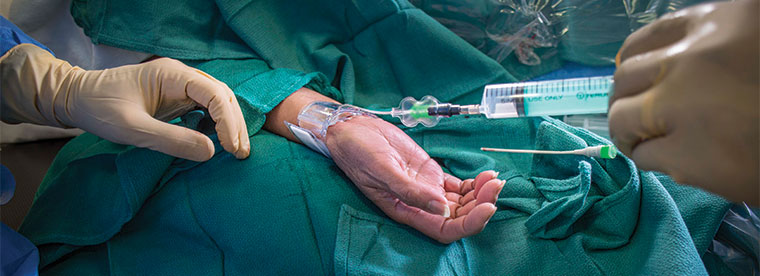Find care now
If you are experiencing a medical emergency, please call 911 or seek care at an emergency room.

Since the 1970s, heart specialists have diagnosed and even treated certain conditions through cardiac catheterization—the process of threading a thin tube through an artery to reach the heart and its vessels. The technique gives cardiologists a close look at what’s going on inside, and even more importantly, the ability to intervene on the spot in cases of blocked, narrowed or weakened arteries.
In fact, cardiac catheterization is so common today that more than 1 million people in the United States undergo the procedure each year. And in nearly every case, cardiologists use the femoral artery, a large vessel deep in the groin, as the point of entry.
But not always.
The Current Landscape
“There’s been a push over the last five years or so to approach cardiac catheterization through the wrist, using the much smaller radial artery,” says Robert Lager, MD, an interventional cardiologist at MedStar Heart & Vascular Institute at MedStar Washington Hospital Center, and president of MedStar Cardiology Associates. “It poses less of a risk of bleeding—the major complication of traditional cardiac catheterization techniques—and it’s more comfortable for patients.”
That’s because recovery from the femoral approach requires patients to remain motionless on their back for four to eight hours to prevent significant post-procedure bleeding and other potential complications. For many, that inconvenience is a small price to pay for a potentially life-saving procedure. But for those with congestive heart failure, back or breathing problems, the protracted time lying flat can be miserable.
By contrast, recovery from the transradial approach is fast and easy.
“In theory, a patient could literally walk off the table after transradial catheterization,” says Dr. Lager, who uses the approach for approximately 80 percent of his cases. “In reality, we keep people in bed for an hour or so post-procedure to monitor for any problems from sedation. But they’re free to sit up, and even get a drink or eat soon afterward.” In addition, the time to discharge is shortened for those going home, and avoiding the groin allows patients to resume more strenuous activities like climbing stairs and aerobic activity earlier in their recovery, adds Dr. Lager.
Transradial cardiac catheterization has been the norm in many parts of Asia and Europe for decades. In the U.S., it currently only accounts for about 30 percent of procedures, in part because of the steep learning curve. However, that ratio is quickly changing.
“As more cardiology fellowship programs train new doctors to use the wrist instead of the groin for cardiac catheterization, we are getting closer to a tipping point of transradial becoming the default approach,” says Dr. Lager. “It’s already the preferred choice among younger cardiologists.”
Who Should Get Transradial Cardiac Catherization?
Not everyone is a good candidate for the transradial catheterization, however. Patients on dialysis may not be eligible, for example. And patients who have had bypass surgery can also pose more technical challenges, although Dr. Lager still uses the wrist for the vast majority of his bypass patients. In fact, national statistics report a 90 percent success rate for the transradial approach overall.
For those who are eligible, however, the advantages in comfort and convenience are compelling.
“Patients are already seeking out physicians who will do the transradial procedure,” concludes Dr. Lager. “As more people learn about its benefits, the demand is only going to increase.”














